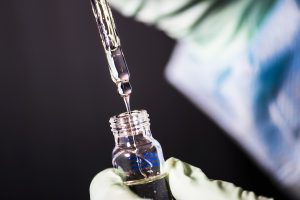A compound is labeled a toxin if it elicits an adverse biological reaction when introduced to another organism. However, this is a limited understanding of how beneficial toxins can be. In this series, we aim to demystify toxins, and show how many can be essentially harmless, and even beneficial.
Can something that is ‘toxic’ also be beneficial? This may seem like a contradiction, but greater scientific knowledge has allowed us to rethink how we view toxins. In our previous article, we mentioned the surprisingly common presence of toxins in everyday life. At lower doses, some compounds that are toxic can be consumed with near total safety. More than that, some toxins can contain extraordinary benefits. Beyond those found in everyday foods and products, there are toxins that are used to better people’s lives in a myriad of ways. Here, we will discuss toxins that are consumed around the world every day, from those that occur naturally in food products, to those that are harvested and utilized for cosmetic and medicinal purposes.

Food for Thought: Common Toxins
A major step in demystifying toxins is understanding how commonplace they are, and perhaps the best way to understand this is to learn how many toxins can be found in the kitchen. Dozens of food products consumed every day contain toxins that, in large doses, can be harmful to humans. “In large doses” is key, as these toxins are most often found in such low quantities (or when food is improperly prepared), that they can be seen as functionally benign. For example, many people enjoy the taste of nutmeg in drinks and desserts during the autumn season, while far fewer know that nutmeg contains myristicin, a compound with neurotoxic effects.[i] Having more than two teaspoons at a time would be an unwise decision, but a person can go the entire fall season eating sweet treats that contain the spice and suffer no ill effects. Similarly, toxic substances found in foods such as almonds (cyanide)[ii], kidney beans (lectins)[iii], and mangoes (urushiol)[iv] can all cause potential harm if these foods are not properly prepared, or ingested in abnormal quantities, but these concerns are so low that they can be consumed every day without incident.

Toxins in Medicine:
Beyond the everyday toxins, there are also toxins that have been utilized in science and aesthetics that are fairly common.

Botulinum toxin: Cosmetic and medicinal uses
One of the most widely utilized toxins is the botulinum toxin, the active ingredient in Botox. While the toxin can cause the deadly paralytic illness known as botulism, administered correctly botulinum toxin can reduce skin wrinkles, making its injection a popular cosmetic procedure. Moreover, botulinum toxin has been shown to be effective in treating various medical conditions, including chronic migraines, muscle spasms, and hyperhidrosis (excessive sweating).[v]
Toxins found in snake venom
When discussing the most valuable substances on earth, some may be surprised to find certain types of snake venom on the list. That is because the same toxic compounds that make snake venom so dangerous can also save lives. As a means for snakes to capture prey, snake venom’s chemical properties that allow it to incapacitate animals are also well-suited for medicinal purposes. Beyond being used to create antivenom for snake bites, some snake venoms contain compounds like captopril and batroxobin that, when isolated, have incredible medical potential to treat conditions as serious (and commonplace) as strokes, heart disease, and kidney issues.[vi]
Antibacterial toxins: Bacteriophages and beyond
Antibiotic-resistant bacteria is a major concern in the treatment of bacterial diseases today. Rampant antibiotic misuse in medical and agricultural settings have allowed these bacterial strains to thrive, resulting in the deaths of tens of thousands of people per year, a number that will only continue to grow as antibiotics prove to be less and less effective. This has led some researchers to explore bacteriocins as a way to stop this worrying trend. These toxins, which are produced by bacteriophages (viruses that infect bacteria), can target harmful bacteria strains that have so far been immune to traditional antibiotics.[vii] With some researchers predicting total antibiotic ineffectiveness by the year 2050, bacteriocins may be the best hope for a viable alternative in treating these diseases.

Toxins: Untapped Medical Potential
Rethinking toxins as a benign, or even positive force in people’s lives may seem difficult to grasp on the surface, but education on the nature of toxins can help us better understand the role toxins can play in improving our lives. Luckily, this knowledge base is expanding. The utility of toxins is an area of research that is constantly growing, with medications in clinical trials and coming to market that would not exist without compounds labeled as toxins. This does not mean all toxins are good for people, nor that there is a safe way to ingest every toxin, but it does show that labelling all toxins as dangerous is short-sighted and neglects their considerable potential.
In the next article, we will discuss Tetrodotoxin, the active ingredient in WEX’s non-opioid analgesic Halneuron®.
[i] Casale, Marc J, et al. “Nutmeg Intoxication: A Case Report.” Cureus, 2023, https://doi.org/10.7759/cureus.46286.
[ii] Chaouali, Nadia, et al. “Potential Toxic Levels of Cyanide in Almonds (Prunus amygdalus), Apricot Kernels (Prunus armeniaca), and Almond Syrup.” ISRN Toxicology, vol. 2013, 2013, pp. 1–6, https://doi.org/10.1155/2013/610648.
[iii] Adamcová, Anežka et al. “Lectin Activity in Commonly Consumed Plant-Based Foods: Calling for Method Harmonization and Risk Assessment.” Foods (Basel, Switzerland) vol. 10,11 2796. 13 Nov. 2021, doi:10.3390/foods10112796
[iv] Yoo, Michael J, and Brandon M Carius. “Mango Dermatitis After Urushiol Sensitization.” Clinical practice and cases in emergency medicine vol. 3,4 361-363. 30 Sep. 2019, doi:10.5811/cpcem.2019.6.43196
[v] Dhaked, Ram Kumar et al. “Botulinum toxin: bioweapon & magic drug.” The Indian journal of medical research vol. 132,5 (2010): 489-503.
[vi] Mohamed Abd El-Aziz, Tarek et al. “Snake Venoms in Drug Discovery: Valuable Therapeutic Tools for Life Saving.” Toxins vol. 11,10 564. 25 Sep. 2019, doi:10.3390/toxins11100564
[vii] Gradisteanu Pircalabioru, Gratiela et al. “Bacteriocins in the Era of Antibiotic Resistance: Rising to the Challenge.” Pharmaceutics vol. 13,2 196. 2 Feb. 2021, doi:10.3390/pharmaceutics13020196